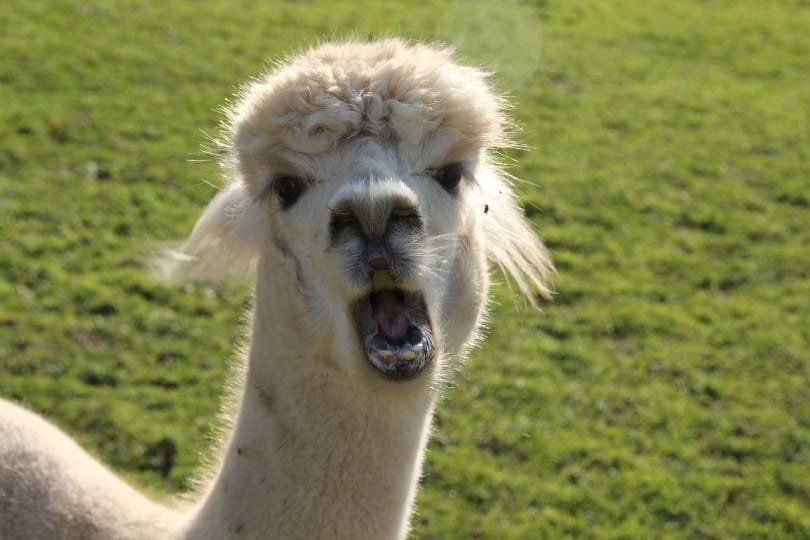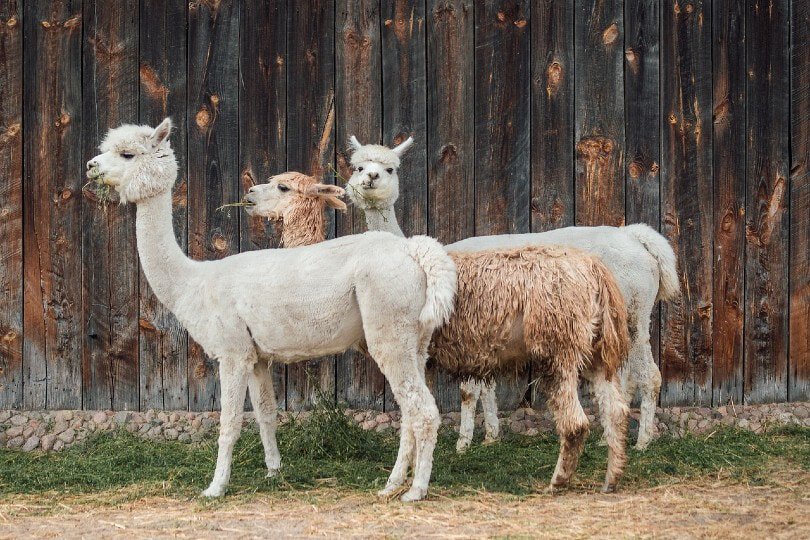Although the meaning of the noise can vary according to pitch, volume, and situation, the most common alpaca noise is that of a hum. Typically, it is a gentle noise. As well as showing general contentment, it is also used to let the rest of the herd know of the alpaca’s presence and that they are OK. Other common noises include a high-pitched shriek, which signifies that the animal is in danger; a clucking noise that shows submission; and a noise called orgling, made by males when mating and has been likened to that of a rusty trumpet.

The 7 Sounds Alpacas Make
Alpacas can be quiet animals that happily go about their business. They will usually be welcoming of human attention and, although they have a reputation for spitting, they only rely on this as a last resort, usually.
Although they aren’t vocal all the time, some commonly heard noises include:
1. Humming
This is the most common alpaca noise and it sounds like a gentle hum. They hum with their mouth closed and the noise can change in pitch and volume. It is actually used to represent a variety of different emotions. It can be used to express contentment and as a means to let the rest of the herd know they are there. It can also be used to show discomfort, and you will have to look for environmental and situational clues to discern between different types of humming noise.
2. Clucking
Clucking, or clicking, is another seemingly multi-purpose noise. Some farmers believe that it is a sign of happiness while others note that it is a noise commonly made by mother alpacas when they are concerned for their cria.
3. Alerting
Alpacas do have a loud alarm call that they use when they sense danger and want to let the rest of the herd know of an impending threat. This sounds similar to that of a donkey’s hee-haw, although not quite as rasping. This noise is specifically made to alert other alpacas to danger.
4. Shrieking
While the alarm call is used to alert others to danger, alpacas have a shrieking noise that is somewhat high-pitched and loud. This isn’t meant to alert others and is usually a sign that they are in imminent danger. Male alpacas also make this noise when fighting other males and may use the noise as a means of scaring other males away.
5. Orgling
This noise is specific to the alpaca and has been described as the noise of a rusty trombone and has even been likened to Chewbacca from Star Wars. The male alpaca makes this noise to attract a female and may continue to make the noise during mating.
6. Snorting
Although they tend to be quite docile creatures, alpacas do like some personal space, and if they feel that another alpaca is encroaching on that space, they will snort at the invader. This noise may be accompanied by spitting.
7. Grumbling
Alpacas grumble when they’re annoyed. It is another noise that represents a desire for more personal space, showing just how important it is to give alpacas a bit of room. While snorting is an active noise, an alpaca will carry on grazing while grumbling so it is more of a passive complaint than an active demand to move.

Other Forms Of Alpaca Communication
Alpacas do have a lot of vocalizations, and these noises are just some of the myriad ways that this ruminant breed can communicate. They use body language, ear twitches, and even bent legs to communicate with other herd members and, while there are some common noises and some similarities between most alpacas, they all have their own specific noises and pitches, which can make it difficult for us humans to recognize the message they are trying to convey.
Do Alpacas Bleat?
Bleating is the noise most often associated with sheep and, while alpacas do make a variety of different noises including a humming noise, they don’t really bleat in the same way as sheep do.
Do Alpacas Screech?
When in imminent danger or in pain, an alpaca makes a shrieking or screeching noise. It is a loud noise and there doesn’t seem to be any particular purpose to it, other than maybe to try and attract the attention of others for assistance. It is more a shriek of fear than a warning or alert call.

Do Alpacas Make Loud Noises?
Generally, alpacas are quiet and docile herd animals that get along well with other alpacas and even other animals. They also tend to be inquisitive and friendly around humans, although they can snort and potentially even spit if they really feel threatened by your presence. The shriek is the loudest noise the herd animal makes, while humming and clucking tend to be quite quiet.
Why Do Alpaca Hum?
The droning, humming noise that alpacas make is the most common vocalization you will hear from these curious animals. Although many people have speculated as to its purpose, there are different views and opinions. Some believe it is a sign that the alpaca is content and happy. Others believe it is a sign that a female alpaca is concerned for the welfare of their young.


Final Thoughts
Alpacas make a variety of noises and for many different reasons. Although humming is the most common noise they make, it is a quiet noise. The shriek and the alarm calls are the loudest noises and may mean that something is really up. Orgling is arguably the most entertaining of noises but it does accompany scenes of mating. While they do have a great variety of vocal noises to call upon, alpacas conduct a lot of communication through body language and physical movements.
Related Alpaca Reads:
Featured Image Credit: kasjanf, Pixabay
